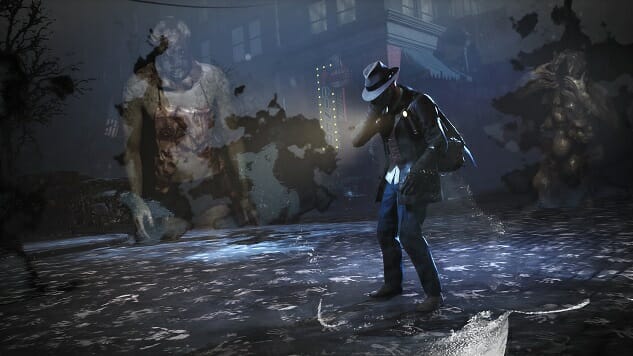Its mission structure also seems to be heavily influenced by Bethesda RPGs, which isn’t necessarily a bad thing if you overlook the often-jarring transitions from action to dialogue. But the missions themselves similarly seem modeled after some of the game’s better put together peers, and as such, it falls into a pattern that it both acknowledges but fails to challenge. As a private investigator, Charles Reed is often sent on errands at the behest of other characters, whether locating a missing person or retrieving a stolen valuable or investigating a crime. It’s a set-up that’s pretty feasible within the parameters of his profession. But the problem is that a lot of times these fetch quests are so deeply nestled within one another that it becomes easy to forget what the original task was in the first place. One person wants you to solve a mystery, your next lead demands a favor, and of course, that can only be fulfilled by tracking something down for someone else. They become such a chain of quid pro quo that after a while, it feels like playing “There Was an Old Lady Who Swallowed A Fly.” And Charles’ dry acknowledgment of it doesn’t lessen the tedium.
Now, if we’re going to discuss fetch quests, it’s almost unfair to single The Sinking City out. After all, it’s a pretty common design convention. Also, Skyrim exists. But The Sinking City lacks the depth to get away with relying so heavily on this type of quest delivery, especially when you consider how it shoe horns in so many other conventions. Its skill tree and weapons could have been a great way to supplement its world-building, yet all feel uninspired and don’t particularly motivate the player’s forward momentum. Adding to that a series of side quests and mini-missions whose objectives can be outright ignored doesn’t help. Amid the game’s greater potential, something’s got to give.
The Sinking City is a bit of a mess, especially in light of how its narrative maneuvers around the deeply racist and xenophobic beliefs of the lore’s author, H.P. Lovecraft. But its potential could be channeled for improvement if it made better use of the observational skills inherent to the detective profession. If there’s any chance for a sequel, my hope is that the developers lean harder into the game’s premise and shed some of its distractions. Or at the very least, give its protagonist a break from being the whole town’s errand boy.
Holly Green is the assistant editor of Paste Games and a reporter and semiprofessional photographer. She is also the author of Fry Scores: An Unofficial Guide To Video Game Grub. You can find her work at Gamasutra, Polygon, Unwinnable, and other videogame news publications.
